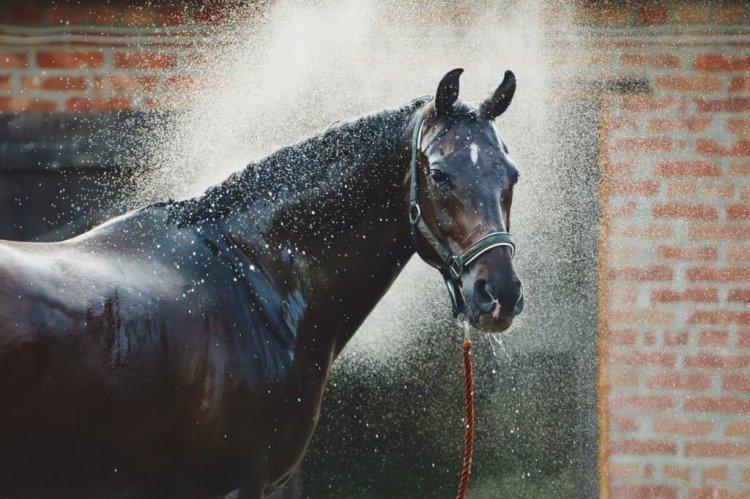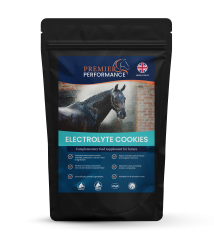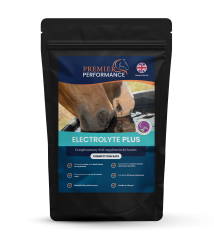in basket
TOP OFFER - SPRING20 - 20% OFF and 4 FREE seasonal products!
Cooling your horse

Temperature regulation in horses
Temperature regulation (also known as thermoregulation) is the ability of the horse’s body to maintain or return to its core internal temperature. As horse owners, we should all be concerned about temperature regulation, especially when the weather is warmer and we are exercising our horses. In order for horses to survive, their internal body temperature is kept within a very narrow range (37.2 to 38.3 oC). Heat is continuously generated in the horse’s body as a result of metabolism and this increases during exercise when the metabolism of energy for exercise occurs and in thoroughbreds, for example, body temperature can rise by over 5 oC.
Horses are actually very efficient at losing heat and having an understanding of this can help us manage our horse’s temperature. Horses lose heat through various mechanisms: convection (heat is moved from deep within the horse into the air), conduction (heat moves from the horse’s blood to the air), direct radiation (heat radiates directly from the horse), and evaporation. Evaporation involves the removal of heat through sweat, the sweat that the horse produces evaporates and this cools the horse down. It is important to note that electrolytes are lost via sweating and these should be replaced in your horse’s diet.
Although horses do not pant like some animals (for example, dogs) they do lose heat via respiration as well. The horse’s cardiovascular system also has an important role in temperature regulation by transferring heat from the site of production, such as the muscles, to areas of the horse where it can dissipate, such as the skin. For example, during exercise blood flow to the skin increases in order for evaporation of sweat to occur. When your horse is being exercised he will dissipate around 70 percent of the internal heat produced through sweating to ensure that his core temperature returns to its resting value. If this does not happen then damage to internal organs can occur as a result of heat exhaustion.
Heat exhaustion
The following is a list of signs that may indicate that your horses may be suffering from heat exhaustion:
- Lethargy
- Decreased appetite
- Thirst
- Nostril flaring
- Dark urine
- Reduced performance
- Muscle spasms
- Irregular heart rhythm
- Slow recovery after exercise
Heat exhaustion is more likely to occur in hot or humid conditions. It is important to acclimatise your horse to working in these conditions and this can take between 2 to 3 weeks of regular exercise in these conditions to have an effect. In the first few days of acclimatisation, horses usually become less able to deal with the heat before improving and therefore a very short period of working in warmer temperature before a competition can actually do more harm.
Cooling your horse after exercise
Having considered how a horse regulates body temperature, it is important to consider how to cool your horse down after exercise. If you suddenly stop exercising with no cooling-down period then circulation in the muscles slows down, trapping heat. Therefore, the aim is to restore your horse’s heart rate and temperature to normal resting levels post-exercise before standing him still. This can be done by keeping your horse walking to allow the blood circulation to continue to pull heat out of the horse’s core and dissipate it through the skin as sweat or via the respiratory tract. You can also offer your horse a drink while he is still warm, there are many myths about allowing horses to drink pre- and post-exercise and the fact is that withholding water is not recommended. Horse should be allowed access to water before being exercised, or competed, and immediately after.
Using cold water to cool your horses is the best way to reduce body temperature after exercise and cold water (15oC or less) should be used all over the horse’s body. In hot weather, ice can be added to the water as water around 5oC is more effective at cooling a horse down. The water should not be scraped off your horse after exercise, by leaving it on the horse it will evaporate and that will help with the cooling process. Washing your horse all over with cold water does not cause muscle cramps or tying-up, again this is a myth.
Feeding electrolytes is also important. If your horse is in work, then electrolytes are required. Commercial feed mixes and forage do contain electrolytes, but only in amounts that are adequate for horses at maintenance or in light work. In particular, the one electrolyte most likely to be deficient is sodium (salt). Therefore, a horse that is doing anything other than light work will not have its electrolyte requirements met without supplementation. See our previous article on electrolytes for further information.
Read our article: Does my horse need an electrolyte supplement?
Summary
Temperature regulation is important in any horse, but particularly in competition horses and those working in higher temperatures. To avoid heat exhaustion:
- Ensure your horses has access to water pre- and post-exercise or competition
- Keep your horse walking until normal respiration has resumed and his temperature has lowered
- Use cold water to wash your horse down
- Do not scrape your horse after washing with cold water
- Provide electrolytes in your horse's diet








